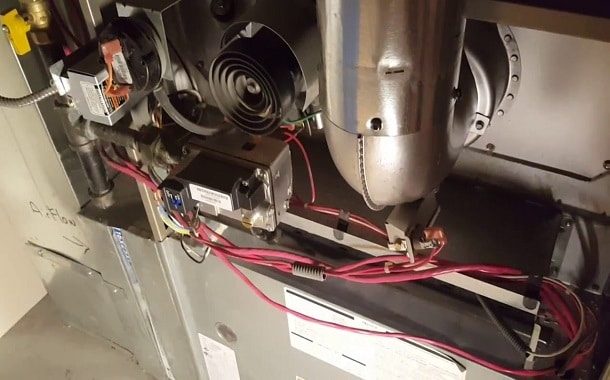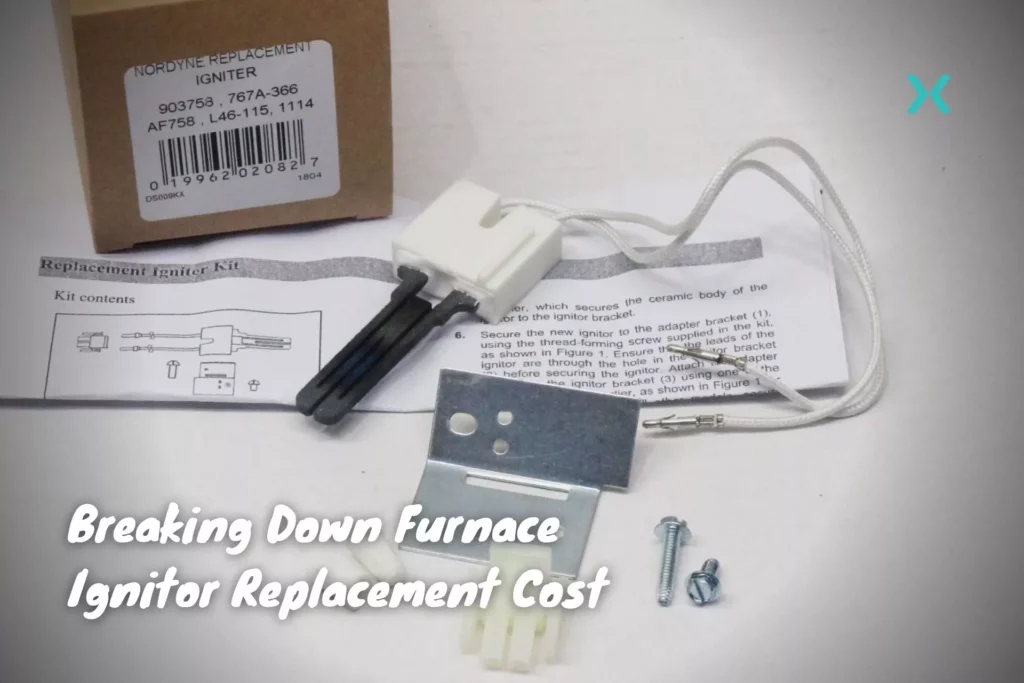Cost To Replace Furnace Ignitor

Furnace Ignitor Replacement: A Homeowner's Guide to Costs and DIY
A malfunctioning furnace can be a homeowner's nightmare, especially during the cold winter months. One common culprit behind a furnace that won't fire up is a faulty furnace ignitor. This guide breaks down the cost of replacing a furnace ignitor, whether you choose to tackle it yourself or call in a professional. We’ll also explore troubleshooting tips and when you absolutely need to leave the job to the experts.
Understanding Furnace Ignitors
The ignitor is a crucial component responsible for igniting the gas in your furnace. There are primarily two types:
- Silicon Carbide Ignitors (Hot Surface Ignitors): These are the most common type, resembling a small, rectangular heating element. They heat up rapidly to a high temperature, igniting the gas.
- Glow Coils: Older furnaces may use glow coil ignitors, which look like a small coil of wire.
Knowing which type you have can help you find the correct replacement.
Signs of a Failing Ignitor
Before jumping to a replacement, it's important to confirm that the ignitor is indeed the problem. Here are some common symptoms:
- The furnace attempts to start, but the burner doesn't ignite.
- You hear clicking sounds, but no flame.
- The furnace cycles on and off repeatedly without properly heating your home.
- The ignitor appears cracked, broken, or damaged upon visual inspection.
Cost Breakdown: DIY vs. Professional
The cost to replace a furnace ignitor varies significantly depending on whether you choose the DIY route or hire a qualified HVAC technician.
DIY Replacement Cost
If you're comfortable working with basic tools and following instructions carefully, replacing the ignitor yourself can save you money. Here's a breakdown of the potential costs:
- Replacement Ignitor: $15 - $60 (depending on the type and brand). You can find these at most hardware stores, appliance parts retailers, and online. Important: Always use an exact replacement or an OEM-approved part.
- Basic Tools (if needed): $0 - $30 (screwdrivers, multimeter, wire connectors). You likely already have some of these.
Total DIY Cost: $15 - $90
Keep in mind that this estimate doesn't account for your time and any potential errors made during the replacement process.
Professional Replacement Cost
Hiring a professional HVAC technician offers convenience and peace of mind, but comes at a higher cost. Here's what you can expect:
- Service Call Fee: $75 - $150 (this is the charge just for the technician to come to your home and diagnose the problem).
- Replacement Ignitor (Professional Grade): $30 - $80 (Technicians often use higher quality parts).
- Labor Cost: $75 - $150 (This will vary depending on the complexity of the job and the technician's hourly rate).
Total Professional Cost: $180 - $380
Note: These are just estimates. Actual costs can vary based on your location, the HVAC company, and the specific furnace model.
DIY Replacement: A Step-by-Step Guide (Proceed with Caution!)
WARNING: Working with gas and electricity can be dangerous. If you're not comfortable with these tasks, please call a qualified HVAC professional. This guide is for informational purposes only and should not be considered a substitute for professional advice.
Tools and Materials Needed:
- New Furnace Ignitor (exact replacement or OEM-approved)
- Screwdrivers (Phillips and flathead)
- Multimeter (to test for voltage)
- Wire Strippers/Crimpers
- Wire Connectors (crimp or twist-on)
- Socket Set (may be needed depending on the furnace model)
- Work Gloves
- Safety Glasses
Step-by-Step Instructions:
- Turn Off the Power: Locate the circuit breaker that controls your furnace and switch it off. This is the most critical step!
- Turn Off the Gas Supply: Find the gas shut-off valve near the furnace (usually a yellow handle) and turn it to the OFF position.
- Locate the Ignitor: Remove the furnace access panel(s) to expose the burner compartment. The ignitor is usually located near the gas burner. Consult your furnace's owner's manual for specific location.
- Inspect the Ignitor: Visually inspect the ignitor for any cracks, breaks, or signs of damage. If it's visibly damaged, it likely needs replacement.
- Test the Ignitor (Optional but Recommended): Use a multimeter to test the ignitor's resistance. Set the multimeter to the "Ohms" setting. Disconnect the wires from the ignitor and place the multimeter probes on the ignitor's terminals. A reading significantly outside the manufacturer's specified resistance range indicates a faulty ignitor. Refer to your furnace's service manual for acceptable Ohm ranges.
- Disconnect the Wires: Carefully disconnect the wires connected to the ignitor. Note the wire colors and their positions to ensure correct reconnection later. You might need to use wire strippers to remove insulation if the existing connections are crimped.
- Remove the Old Ignitor: Depending on the design, the ignitor may be held in place by screws or a clip. Remove the fasteners and carefully slide out the old ignitor.
- Install the New Ignitor: Insert the new ignitor into the same position as the old one. Secure it with the screws or clip.
- Reconnect the Wires: Reconnect the wires to the ignitor, matching the colors to their original positions. Use wire connectors to ensure secure connections.
- Replace the Access Panel(s): Put the furnace access panel(s) back in place, ensuring they are securely fastened.
- Turn On the Gas Supply: Slowly turn the gas shut-off valve back to the ON position.
- Turn On the Power: Switch the circuit breaker back on.
- Test the Furnace: Set your thermostat to call for heat and observe the furnace's operation. It should go through its normal start-up sequence and ignite the burner.
- Monitor for Issues: Stay near the furnace for the first few heating cycles to ensure it's operating correctly and there are no gas leaks or other problems. Listen for unusual noises or smells.
Troubleshooting After Replacement
If the furnace still doesn't work after replacing the ignitor, consider these possibilities:
- Incorrect Ignitor: Make sure you used the correct replacement part.
- Loose Wire Connections: Double-check all wire connections to the ignitor and other components.
- Flame Sensor Issues: The flame sensor detects the presence of a flame and shuts off the gas if no flame is detected. A dirty or faulty flame sensor can prevent the furnace from staying lit. The flame sensor is a metal rod near the burners that can be cleaned with steel wool.
- Gas Supply Problems: Verify that the gas supply is turned on and that there are no issues with the gas line.
- Other Furnace Problems: There could be other underlying problems, such as a faulty gas valve, control board, or pressure switch.
When to Call a Professional
While replacing a furnace ignitor can be a manageable DIY project for some, there are situations where it's best to call a professional HVAC technician:
- You're not comfortable working with gas or electricity.
- You're unsure about any part of the replacement process.
- The furnace is under warranty (DIY repairs may void the warranty).
- The problem persists after replacing the ignitor.
- You suspect a gas leak.
- You notice any unusual smells or noises coming from the furnace.
- You don't have the necessary tools.
Safety First! If you suspect a gas leak, evacuate your home immediately and call your gas company or 911 from a safe location.
Preventative Maintenance
Regular furnace maintenance can help prevent ignitor failures and other problems. Consider these tips:
- Schedule annual furnace inspections and tune-ups by a qualified HVAC technician.
- Replace the furnace filter regularly (every 1-3 months, depending on usage).
- Keep the area around the furnace clean and free of debris.
Finding a Reliable HVAC Technician
If you decide to hire a professional, here are some tips for finding a reputable HVAC technician:
- Get recommendations from friends, family, or neighbors.
- Read online reviews and check ratings on websites like Yelp and Google.
- Verify that the technician is licensed and insured.
- Get multiple quotes before making a decision.
- Ask about their experience with your specific furnace model.
By understanding the potential causes of a furnace failure, the cost of replacement, and the steps involved in DIY repair, you can make informed decisions about how to best address your furnace issues and keep your home warm and comfortable all winter long.










